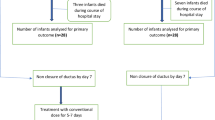Abstract
Patent ductus arteriosus (PDA) remains a common problem in premature infants. Treatment options include pharmacologic therapy and surgical ligation, but these are associated with potentially significant adverse effects. This report describes the effect of administering oral paracetamol to premature neonates with PDA. The study enrolled seven premature neonates followed up with the diagnosis of hemodynamically significant PDA (hsPDA) between February and December 2012 and treated with oral paracetamol. Patients with hsPDA were given at least two or more courses of ibuprofen treatment. If this therapy failed to promote ductal closure, the patients with clinical symptoms who had hsPDA defined by echocardiography were treated with oral paracetamol (15 mg/kg every 6 h). If these patients did not respond to paracetamol therapy, the PDA was closed by surgical ligation. The mean gestational age of the seven patients in this study was 26.1 weeks, and their mean birth weight was 936 g. Paracetamol treatment was started at 36.2 ± 11.6 days. The mean internal ductal diameter was 2.0 ± 0.2 mm, and the left atrium-to-aorta ratio was 1.5 ± 0.2. All the patients were administered oral paracetamol because of no response to ibuprofen treatment. The hsPDA was successfully closed with oral paracetamol in five (71.4 %) of the seven patients. The remaining two patients had surgical ligation performed, but one of them died. No side effects related to paracetamol were observed. Oral paracetamol may be used as an alternative drug for the management of hsPDA in premature neonates when ibuprofen treatment is unsuccessful and the only other therapeutic option is surgery.
Similar content being viewed by others
References
Chiruvolu A, Jaleel MA (2009) Therapeutic management of patent ductus arteriosus. Early Hum Dev 85:151–155
Clyman RI (2012) Patent ductus arteriosus in the preterm infant. In: Gleason CA, Devaskar SU (eds) Avery’s diseases of the newborn, 9th edn. Elsevier Saunders, Philadelphia, pp 751–761
Gokmen T, Erdeve O, Altug N, Oguz SS, Uras N, Dilmen U (2011) Efficacy and safety of oral versus intravenous ibuprofen in very-low-birthweight preterm infants with patent ductus arteriosus. J Pediatr 158:549–554
Hammerman C, Bin-Nun A, Markovitch E, Schimmel MS, Kaplan M, Fink D (2011) Ductal closure with paracetamol: a surprising new approach to patent ductus arteriosus treatment. Pediatrics 128:1618–1621
Hamrick SE, Hansmann G (2010) Patent ductus arteriosus of the preterm infant. Pediatrics 125:1020–1030
Kulmacz RJ, Wang LH (1995) Comparison of hydroperoxide initiator requirements for the cyclooxygenase activities of prostaglandin H synthase-1 and -2. J Biol Chem 270:24019–24023
Lucas R, Warner TD, Vojnovic I, Mitchell JA (2005) Cellular mechanisms of acetaminophen: role of cyclo-oxygenase. FASEB J 19:635–637
Oncel MY, Yurttutan S, Uras N, Altug N, Ozdemir R, Ekmen S et al (2013) An alternative drug (paracetamol) in the management of patent ductus arteriosus in ibuprofen-resistant or contraindicated preterm infants. Arch Dis Child Fetal Neonatal Ed 98:F94
Oncel MY, Yurttutan S, Degirmencioglu H, Uras N, Altug N, Erdeve O et al (2013) Intravenous paracetamol treatment in the management of patent ductus arteriosus in extremely low birth weight infants. Neonatology 103:166–169
Tekgunduz KS, Ceviz N, Demirelli Y, Olgun H, Caner I, Sahin IO, Yolcu C (2013) Intravenous paracetamol for patent ductus arteriosus in premature infants: a lower dose is also effective. Neonatology 104:6–7
Van Overmeire B, Chemtob S (2005) The pharmacologic closure of the patent ductus arteriosus. Semin Fetal Neonatal Med 10:177–184
Yurttutan S, Oncel MY, Arayıcı S, Uras N, Altug N, Erdeve O et al (2013) A different first-choice drug in the medical management of patent ductus arteriosus: oral paracetamol. J Matern Fetal Neonatal Med 26:825–827
Zahka KG, Erenberg F (2011) Congenital defects. In: Martin RJ, Fanaroff AA, Walsh MC (eds) Fanaroff and Martin’s neonatal–perinatal medicine: diseases of the fetus and infant, 9th edn. Elsevier Mosby, St. Louis, pp 1245–1266
Author information
Authors and Affiliations
Corresponding author
Rights and permissions
About this article
Cite this article
Özdemir, Ö.M.A., Doğan, M., Küçüktaşçı, K. et al. Paracetamol Therapy for Patent Ductus Arteriosus in Premature İnfants: A Chance Before Surgical Ligation. Pediatr Cardiol 35, 276–279 (2014). https://doi.org/10.1007/s00246-013-0770-9
Received:
Accepted:
Published:
Issue Date:
DOI: https://doi.org/10.1007/s00246-013-0770-9




